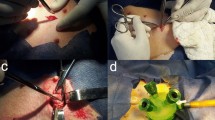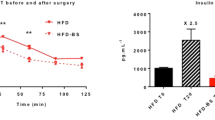Background: Omental adipose tissue specimens of female rats that were fed a high fat (HF) diet were evaluated stereologically and histopathologically. To our knowledge, there is no stereological study on numerical density, nuclear height and volume of adipocytes in omental adipose tissue in the female rat fed a HF diet in the literature. Method: 20 female Spraque Dawley rats were used in the study. 10 of the animals were fed HF diet consisting of 30% of calories from fat for 3 months. The remaining 10 rats, the control group, were fed a normal diet. After the experimental procedure, all animals were anesthetized and omental adipose tissues in the same area were dissected and fixed for the histochemical process using a mixture of 3% glutaraldehyde and 1% osmium tetraoxide in 0.1 M phosphate buffer. After embedding of tissues in araldite CY 212, semi-thin and thin sections were cut. The semi-thin sections were stained with toluidine blue. The physical dissector counting method was used for estimation of numerical density and nuclear height of adipocytes. Cavalieri principle was used for the estimation of adipocyte volume; volume fraction approach was applied to find the volume fraction of adipose tissue components. Results: The mean numerical density of adipocytes in the HF diet group was significantly higher than the control. The mean nuclear height of adipocytes was also very high in the HF diet group. The volume fraction of adipose mass was increased whereas the extracellular matrix volume fraction was reduced in the HF diet group compared to the controls. The mean volume of adipocytes in the HF diet group was also significantly higher than in the control group. At the light microscopy level, it was found that adipocytes were enlarged and gaining irregular shape in the HF diet group. Thicker basal lamina and electron dense lipid content were also found in this group at the electron microscopy level. Conclusion: Lipid content and number of adipocytes in the adipose tissue of HF diet rats were higher than in the controls. Thus, HF diet induces increase in body weight via both hypertrophy and hyperplasia of adipocytes.
Similar content being viewed by others
Author information
Authors and Affiliations
Rights and permissions
About this article
Cite this article
Aslan, H., Altunkaynak, B.Z., Altunkaynak, M.E. et al. Effect of a High Fat Diet on Quantitative Features of Adipocytes in the Omentum: An Experimental, Stereological and Ultrastructural Study. OBES SURG 16, 1526–1534 (2006). https://doi.org/10.1381/096089206778869942
Published:
Issue Date:
DOI: https://doi.org/10.1381/096089206778869942




